
American
Romanticism:
Lecture notes
Thursday 28 August: Syllabus / webpage review; introduce assignments & objectives; students indicate presentation preferences; sample poems.
|
|
|
|
|
|
Thursday 28 August: Syllabus / webpage review; introduce assignments & objectives; students indicate presentation preferences; sample poems.
Pre-Romantic Writings: American Origins
Thursday 4 September: Columbus, N 24-28; Selections from Genesis (handout); John Smith, N 43-53. Mary Rowlandson, N 117-134. Thomas Jefferson, N 338-346.
text-objective discussion leader:
poetry: Anne Bradstreet, “To my Dear and Loving Husband,” N 108.
poetry reader / discussion leader:
Pre-Romantic & Early Romantic Writings
Thursday 11 September: Jonathan Edwards, N 168-170 (introduction), 194-205 (Sinners in the Hands of an Angry God, esp. beginning and end), 170-180 (Personal Narrative); Susanna Rowson, selections from Charlotte Temple: A Tale of Truth (web post); Washington Irving, N 453-466 ("Rip Van Winkle"), "The Legend of Sleepy Hollow" (web post).
text-objective discussion leader:
poetry: James Wright, "A Blessing," N 2613
poetry reader / discussion leader:
web highlight (midterms):
Self-introduction
Some of you know me from multicultural and world literature courses, but my training and scholarship concentrated in early American literature, especially the Romantic period
My doctoral dissertation covered several of our authors
First grad course I ever taught here was this one . . . .
Have taught the course more than half a dozen times
So for better or worse, this course finds me fully loaded . . .
But American Romanticism also finds students at least partly loaded on the subject.
Everyone in our course has some idea of Romanticism--
but get used to a lot of possibilities, most of which are both attractive and dangerous
Some elements are more or less universal, timeless, inherent in human nature
But also historical--by most accounts, what we now call Romanticism began in Europe between 2-3 centuries ago, in late 1700s through 1800s
But if you're a true Romantic, you don't like to think that your reality or perceptions are determined by historical conditions
Result:
Romanticism always escapes any reductive or down-to-earth definition--that's reality or realism, not Romanticism
Many different, even contradictory qualities are considered Romantic
resort to metaphors:
A "baggy" concept,
or oceanic, full of cross-currents, beautiful and threatening creatures or places,
tropical beaches and northern wastes, a spring morning and a hurricanes
Romanticism is huge, intimate, powerful, gone . . .
It works on us all one way or another
Each of us will personalize what we read this semester
Think we know the secret, the way into the subject and our private claim to beauty and meaning
Before the break, when we fill out our ID cards, ask you all to write down some image or association with the idea of Romanticism--anything--and after the break we'll discuss.
Notes regarding postings:
Postings are required as a record of your presentation.
Most students send me their postings before class and use them as part of their presentations.
But . . . postings are not absolutely required before class, just eventually. If something goes wrong and you just "present" without a web posting, that's perfectly OK, exactly how we used to do it all the time before web projectors took over classrooms.
If you present without a posting, send the posting before the next class meeting. Please don't make me remind you.
Notes on syllabus regarding email, webpage uses . . . .
In a few days, I'll email everyone a draft of the presentation schedule
If you see problems, reply by Sunday night; otherwise I'll bring paper copies for everyone next Monday
ID cards
NAME as you want it to appear on schedule
contact information: email(s), phone(s), US Mail
PRESENTATION PREFERENCES
("No preference" is an acceptable answer to any of these questions.)
Would you prefer poetry, reading, or web-highlight presentation?
If poetry, particular poet or poem from listings?
If selection, particular day or author?
If web highlight, day?
(Provide me with as much information or as many options as you like)
Days when you know you won't be in class?
Volunteers for Next Monday?
Anything to tell me about your situation this semester?
—volunteers for next week?
Pre-Romantic Writings: American Origins
Thursday 4 September: Columbus, N 24-28; Selections from Genesis (handout); John Smith, N 43-53. Mary Rowlandson, N 117-134. Thomas Jefferson, N 338-346.
text-objective discussion leader:
poetry: Anne Bradstreet, “To my Dear and Loving Husband,” N 108.
poetry reader / discussion leader:
assignments
(The Bradstreet poem is written far before the Romantic period, but how does it anticipate Romantic ideas or attitudes?)
From syllabus . . .
· For interpretation, three standard questions to consider:
1. What is “Romantic” about the poem? (Refer to course objectives or previous discussions, or speculate on additional meanings of Romanticism or “romantic.”)
2. What in the poem resists or violates Romanticism or a romantic interpretation?
3. What about the poem seems identifiably American?
Instructor's questions for readings:
Columbus:
How do Columbus's letters trace a romance narrative? How are Romanticism and America combined from the first European explorers? How does "Reality" intrude?
Columbus and Genesis:
How does Columbus recreate the Genesis story? (both in text and in popular-historical attitudes toward "discovery of America")
Mary Rowlandson:
How is this "captivity narrative" (i. e., a white settler taken hostage by the Indians) like and unlike a romance?
(Larger purpose of Rowlandson text: Cooper's Last of the Mohicans is a captivity narrative)
Jefferson pp 334-42 (intro and Declaration of Independence)
Compare to Columbus and Genesis as an "origins story" or "creation myth"
What
is Romantic about the Declaration of Independence?
(all 3 aspects of obj. 1: period, style, narrative)
sample poems
Questions:
What's Romantic about each poem? What's not?
What overall themes or styles emerge?
What other terms compete with the terms of Romanticism? What different kinds of prestige or appeal do different styles or genres offer?
If I asked each of you right now, "What is Romanticism?" or "Who were some Romantic authors?", nearly all of you could come up with some kind of answer.
"What is Romanticism?" -- "love of nature" or parts of each
"Who were some Romantic authors?" -- Wordsworth, Poe, others?
Romanticism is a very big concept with a very long history, so from the start I've taught it as a survey, so that students can see it showing up at various points in various texts and movements
Not really an exotic concept--
teaching principle of starting where students are, incorporating new knowledge with established knowledge
Two verbal exercises:
What is "Romanticism?" > "Romantic" (or "romantic")
"Romantic" is a word we don't use every day, but most of us can use it or at least process it.
First Question: What do we mean when we say . . . ?
"How romantic!", or
"S/he's a romantic . . . ."
Examples? Assumptions? Words or concepts that might accompany such speech?
Second Question: What do we mean when we say . . . ?
> self-knowledge: if you're a Literature or Humanities major, you're a romantic.
Possible reaction: embarrassment . . . can't change the oil on my car or manage money . . . .like so-called "Realists" can do and think I should do . . . .
What's the value of such an identity? How and why does it survive and thrive?
Spend the whole semester and only get started, but good to get started . . . .
Romanticism is a big, essential concept in modern existence, and nearly everyone carries some of it around in their hearts and minds.
Another exercise!
Background: Romanticism as a movement is
International
(Starts in Germany in mid-to-late 1700s > France, England, other European States > North and South America)
Interdisciplinary, not just limited to literature
(Music, visual art, dance, tourism)
General progression of movements:
"Classical or Neo-Classical movement" > "Romantic movement"
(Contrast to "romantic" vs "realistic"; if you're doing history of art, it's more standard to do "Romantic" vs. "Classical")
Listen to some historical classical music
Mozart, string quartet ("Classical"; late 1700s, on verge of Romanticism)
Beethoven, string concerto ("Romantic," early 1800s, full-blown Romanticism)
Chopin, nocturne (slightly later, less heroic but still Romantic)
Warning: the period or movement distinctions made here are drastically simplified. Mozart can be pretty Romantic sometimes, and Beethoven starts out as a late Classical composer.
Questions for Mozart: How describe it as "Classical?"
Questions for Beethoven and Chopin: How describe it as "Romantic?"
types of presentations
poetry reader / discussion leader:
text-objective discussion leader (a. k. a. selection reader / discussion leader)
web highlight
Monday 11 September: Jonathan Edwards, N 182-194, 207-219; Susanna Rowson, Charlotte: A Tale of Truth (handout); Washington Irving, N 446-460 ("Rip Van Winkle"), "The Legend of Sleepy Hollow" (handout).
selection reader / discussion leader:
poetry: James Wright, "A Blessing," N 2752
poetry reader / discussion leader:
discuss "romance"
Objective 1: Literary Categories of Romanticism
· To identify and criticize ideas and attitudes associated with Romanticism, such as desire and loss, rebellion, nostalgia, idealism, the gothic, the sublime, the individual in nature or separate from the masses.
· The Romantic impulse may be as simple as a desire for anything besides “the here and now”—or “reality”; thus the quest or journey of the romance narrative involves crossing physical borders or transgressing social or psychological boundaries in order to attain or regain some transcendent goal or dream.
· A Romantic hero or heroine may appear empty or innocent of anything except readiness or desire to transform or self-invent.
Objective
1b. The Romantic Period
· To observe Romanticism’s concentration in the late 18th through the 19th centuries and its co-emergence with the rise of the middle class, the city, industrial capitalism, consumer culture, and the nation-state.
· To observe predictive elements in “pre-Romantic” writings from earlier periods such as “The Seventeenth Century” and the "Age of Reason."
· To speculate on residual elements in “post-Romantic” writings from later periods incl. “Realism and Local Color,” "Modernism," and “Postmodernism.”
Objective
1c: Romantic Genres
To describe & evaluate leading literary genres of Romanticism:
·
the romance narrative
or novel (journey from repression to transcendence)
·
the gothic novel
or style (haunted physical and mental spaces, the shadow of death or decay;
dark and light in physical and moral terms; film noir)
· the lyric poem (a momentary but comprehensive cognition or transcendent feeling—more prominent in European than American Romanticism?)
· the essay (esp. for Transcendentalists—descended from the Puritan sermon?)
Nearly all students become comfortable with "Romantic spirit" and "Romantic period," but less comfortable with "romance"
"romance" also in our vocabulary, but
popular usage more specialized than academic usage.
popular use: "romance" = women's novel, love story
academic use: much broader concept, can be applied to a wider range of genres
"romance" as a narrative genre
Questions:
1. What are some current or familiar examples of the romance narrative?
2. Why do students have trouble comprehending or using "romance" as an intellectual concept?
[Prof's answers to question 2:
Cognitive dissonance: students already have a concept of "romance" as "women's love story"--difficult to write over--humans avoid cognitive dissonance
Narrative itself is a difficult concept!]
guide to literary & cultural periods
| Period |
17c |
18c
Age of Reason; Enlightenment; Neoclassicism |
Late
18th-19c Romanticism |
| Dominant
intellectual power |
Religious
passion |
Reason;
empirical thought |
Imagination,
"fancy" |
| Style
and stylistic effects |
"Baroque":
extended metaphor or "conceit"; Puritan plain style |
"Classical":
clarity, symmetry, balance, temperance; satire, irony |
The
Sublime (pain & pleasure mixed on the grand scale); the Gothic (gloom,
decay, mystery); nostalgia |
| Human scene | Individual
soul, covenant or community of believers |
State
or society of autonomous equals (with many blind spots) |
Individual
alone in nature; society in older, gothic settings |
| Where's
God? (or spirit) |
Individual
soul, coventant, community |
God
created nature, but separate from nature; "Providence" |
God
or spirit increasingly dispersed in nature; also in individual human |
| Representative
European authors |
Donne,
Herbert, Milton |
Racine,
Corneille, Dryden, Pope, Swift, Johnson |
Goethe,
Schiller, Hugo, Dumas, Blake, Wordsworth, Coleridge, Byron, Shelley(s), Keats |
| Representative
American authors |
Taylor,
Bradstreet, Mather, Rowlandson, Edwards |
Franklin,
Jefferson, Paine |
Early:
Freneau, Irving, Cooper; "American Renaissance" (1840s-50s):
Poe, Emerson, Hawthorne, Thoreau, Melville, Whitman, Dickinson, Stowe,
Douglass |
| Music
(European) |
Bach,
Handel, Vivaldi |
Mozart,
Haydn |
Beethoven,
Chopin, Schubert, Wagner, Tchaikovsky |
| Role of literature | Exploration
and development of religious feeling; Expression of shared values in
community of faith |
Rational
exposition and analysis of physical and human nature. Community of shared
interests |
Entertainment
and escape for leisured classes; modeling of manners and behavior in
rapidly changing society |
| Attitude
toward social difference |
"Us
and Them"; for us or against us |
Tolerance;
diversity of human nature recognized + attempt to recognize universal
human rights |
Sympathy;
rebel or outsider becomes hero |
| Attitude
toward government |
Religious
state; early nationalism |
Limited
government, low taxes, freemarket economics |
Rise
of bourgeois nation-state (France under Napoleon); imperial expansion |
European and American names and periods
| Category / period | Eighteenth
Century
"Enlightenment," "Age of Reason," "Neo-Classical," "Classical" period |
Early
19th Century
Age of Revolution Romantic period |
| Music | "Classical Music"
Haydn Mozart |
"Romantic Music"
Beethoven, Chopin, Schubert, Liszt, Wagner |
| Art | Poussin, David, Copley, Caspar | Constable, Turner, Cole, Church |
| Literature | England: Pope, Swift, Johnson
USA: Franklin, Hamilton, Madison, Paine, Jefferson |
Germany:
Goethe, Heine, Schiller
France: Lamartine, Hugo England (1788-1832): Blake, Wordsworth, Coleridge, Byron, Percy & Mary Shelley, Keats, Brontes USA (1820s-1861, a. k. a., "American Renaissance): Cooper, Emerson, Hawthorne, Poe, Lincoln, Fuller, Melville, Whitman, Dickinson, Thoreau, Stowe, Douglass |
| "ideology": material reality & attitudes | Established material base,
institutions, and ideology of modern civilization:
· Capitalism (Wealth of Nations, 1776) · Scientific revolution (Newton) · Urbanization, internationalization · Increasing lifespans, population growth · USA: Declaration and Constitution |
Increased leisure, affluence,
& dislocation depend on 18th-century institutions but
foster contrary aesthetics:
· Conformity / Individualism · Industrialization, urbanization, growth, devastation of nature, revolution in lifestyles / sentimental love of nature, tradition · Loss of extended family / glorification of nuclear family, domesticity, "family values" |
European-American
Art, Classical and Romantic
Classical (eighteenth century; “Enlightenment,” scientific revolution, “Age of Reason”)
stylistic tendencies: hard edges, clear colors, focused light
subject tendencies: historical figures, social and historical settings, human figures in foreground
Poussin, Et in Arcadia Ego (1647)
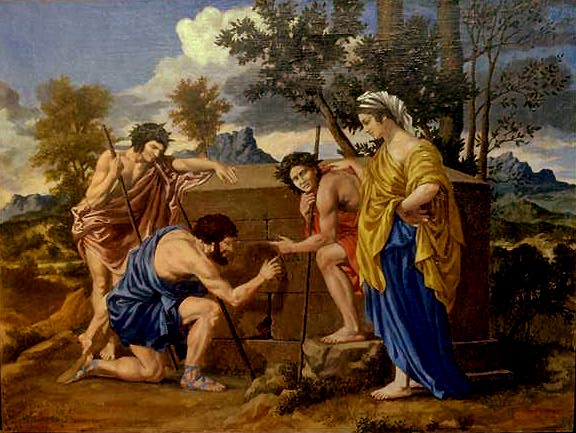
John Singleton Copley, Death of Major Pierson, 1782-84

Copley, Paul Revere 1768-70
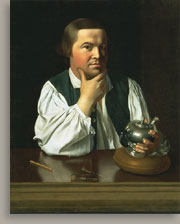
Copley, Mrs. Thomas Boylston 1766

Romantic (nineteenth century; urbanization and industrialization) “Hudson River School” of American Romantic painters
· For interpretation, three standard questions to consider:
1. What is “Romantic” about the poem? (Refer to course objectives or previous discussions, or speculate on additional meanings of Romanticism or “romantic.”)
2. What in the poem resists or violates Romanticism or a romantic interpretation?
3. What about the poem seems identifiably American?
Thomas Cole, Hunter’s Return 1845
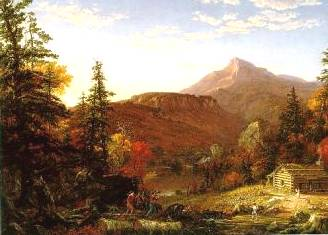
Cole, scene from Last of the Mohicans

Asher Brown Durand, Kindred Spirits 1849
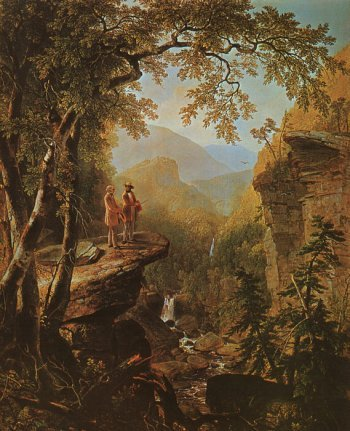
George Inness, Lackawanna Valley 1855
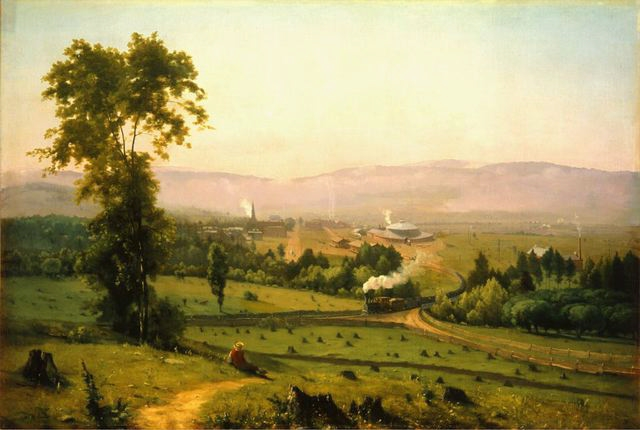
Frederic Edwin Church, Niagara Falls 1857
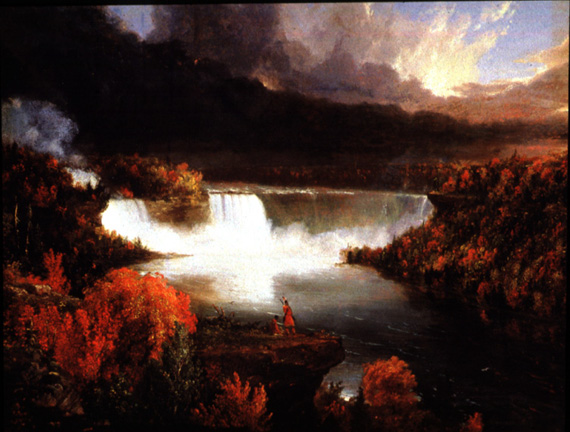
Church, Icebergs 1861

compare Classical and Romantic treatments of similar subjects
Audubon, Gyrfalcon 1833
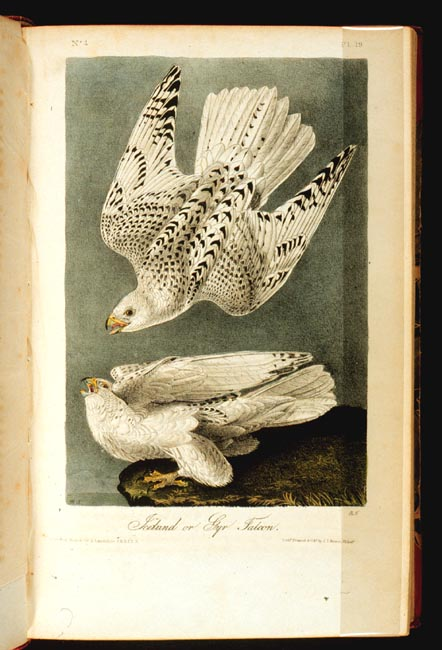
Heade (1819-1904), Hummingbirds & Orchids (no date)
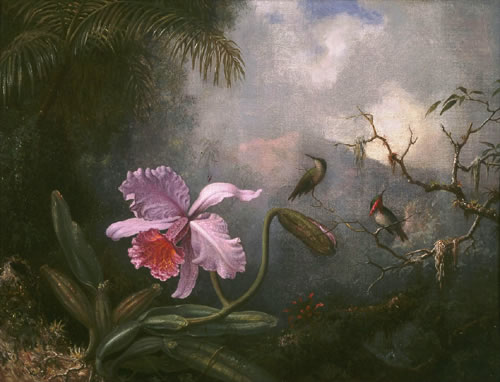
Classical (eighteenth century; “Enlightenment,” scientific revolution, “Age of Reason”)
stylistic tendencies: hard edges, clear colors, focused light
subject tendencies: historical figures, social and historical settings, human figures in foreground
Romantic painting
stylistic tendencies: softer edges and colors, diffuse light
subject tendencies: nature, human figures in background, human figures diminished, human figures not historical but fictional or “types”

